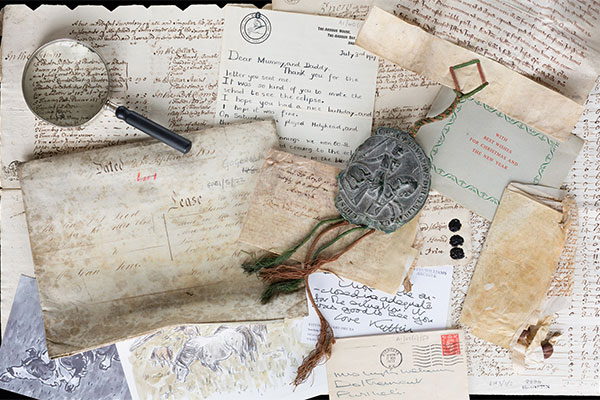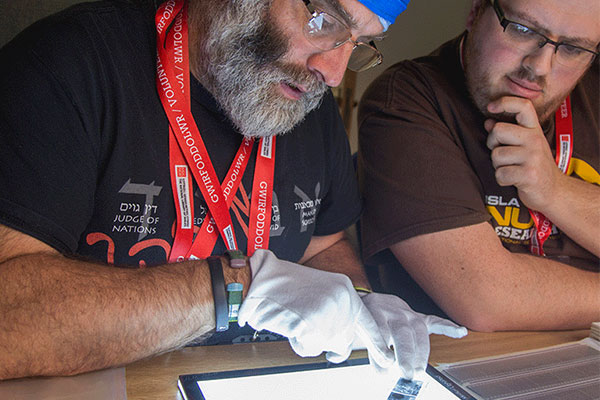Welsh place names have been in the spotlight recently. There have been a number of negative stories in the press of centuries old place names being replaced by English language names with little or no connection to the history of the place. Whilst other names are disappearing from maps completely in favour of more ‘popular’ English variants. However there has also been something of a seed change with the Eryri National Park leading a shift towards adopting original Welsh place names as the official name of places in both English and Welsh. Most notably they proclaimed that Wales’ highest mountain would be formally known as Yr Wyddfa in both languages. The Brecon Beacons National Park has followed suit by adopting the Welsh name as the main name, as shown above.
The National Library of Wales has been working hard in this space too, crowdsourcing Welsh names for historic sites, improving Wikipedia articles about Welsh places and recording sound clips of local people pronouncing their place names. The Library has made all this data available via Wikidata, a sister project of Wikipedia aimed at collecting and sharing the world’s knowledge as open data.
The Welsh Language Commissioner's office has been at the center of efforts to raise the profile of Welsh place names and to highlight the importance of safeguarding them for the future. They maintain and develop a comprehensive database of thousands of Welsh place names with standardized spellings in both English and Welsh.
With support from the Welsh Government, the National Library of Wales has been working closely with the Welsh Language Commissioner to align their place names dataset with the crowdsourced data on Wikidata. This alignment means that we can now connect places named in their dataset with content about that place on Wiki, including Wikipedia articles, photographs and any other datasets already aligned to Wikidata, such as CADW’s register of listed buildings. We’ve also fully aligned their data to our experimental name authority database (SNARC) which aims to link Welsh heritage data together in a linked, bilingual and open access dataset.

One big benefit of using Wikidata as a hub for linking all this data together is that it’s a multilingual platform, and it’s open for anyone to edit. This means we can capture place names in English and Welsh. We can also record an unlimited number of variations or specify official spellings or historic spellings. And since anyone can edit and comment, it is a democratic space. Local people contributing here may feel strongly about a particular form for their local place, which might differ from the official standardized form, but the data remains connected together, so users of the data can decide which version of a place name they wish to use.
The benefits of connecting our datasets together are twofold. Firstly we are able to present rich data about Welsh places in one place, even though the data comes from multiple sources. This enables us to combine data produced by Welsh organisations with crowdsourced data on Wikidata. This means that the public and public sector organisations can effectively work together to create better resources and services for the benefit of all.
Secondly, having all our data connected makes it easier for us to present our data to a common standard. With place names, this means we can all apply the standardized spellings of places, where appropriate, on our own platforms. It also helps us root our mistakes or gaps in individual datasets. Through this process we found a number of duplicate or mislabelled Wikipedia entries and even a few duplicates in the Welsh Language Commissioner's data. However it is now much easier to correct mistakes across all datasets.
The Welsh Language Commissioner recently launched a new website for searching their list of Welsh place names and were keen to take advantage of the data enrichment work of the National Library of Wales. The new website includes links to relevant Wikipedia articles, in English and Welsh, images and sound clips from Wikidata and links to relevant entries in the Coflein and Historic Welsh Place Names datasets, managed by the RCAHMW. This was possible in large part due to the alignment of the data with Wikidata. Users of the new website benefit not just from the work of the Commissioner and their partners but the works of thousands of volunteers who recorded sound bites, took photographs or wrote Wikipedia articles, creating a much richer user experience.

You can find the Welsh Language Commissioner Standardised Welsh Place-names List here!
We are now looking at ways of keeping the website up to date with new content from Wiki, and making sure data stays aligned long term. The National Library is already planning to run an event with the Welsh Language Commissioner to collect and record places names from Eryri National Park and to record local people pronouncing those names. We hope to expand this model of collaboration across the sector, to make the most of our data, to collaborate with the public on the collection and creation of knowledge resources and, above all, to promote the use of the Welsh language.
Jason Evans,
Open Data Manager
Category: Article




